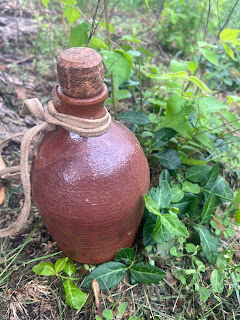I’m never exactly sure how to write these immersion recaps. Should I simply tell it as it happened? Should I write it as though it’s an 18th-century narrative, straight from the Draper Manuscripts? I never know. So I suppose I’ll do a little of both—maybe. We’ll see how it goes.
After traffic delays and some van battery issues, I finally arrived on site late Thursday evening. David and Dillon were already there and had gone into the woods. Elijah had arrived as well, and he and I quickly kitted out and went looking for our native counterparts. We spent the first night camped together, and by the next day the rest of our parties had arrived.
By mid-afternoon Friday, the hunting party was assembled and in the woods: five men total—myself, Elijah, Joshua, Ehrin, and Sayer. Elijah had brought some green deer hides, and he and Sayer set about making frames to stretch and hang them. While they worked, Joshua, Ehrin, and I began construction on the half-face shelter. We had one good felling axe, several belt axes, and a crosscut saw.
Work was going well when suddenly natives were spotted on the ridge above. Our camp was, admittedly, poorly placed. We sprang to our rifles and managed to drive them off. After that, we became more vigilant.
Later, I went to the spring for water and was ambushed by the native party. I managed to escape when the rest of my group came to my aid. We made a second attempt at dusk, but they had crept closer to camp and sprang an ambush. The fight that followed was intense and close-quarters—in the darkness, we could see them only by the flashes from their firelocks.
I passed a sleepless night, cold and uncomfortable. In the early hours, Elijah and I rose and built a small fire, keeping a watchful eye on the ridge. As the rest of the party stirred, we warmed salt pork over the fire and resumed our work through the morning.
While sitting on the back log of our half-face shelter, I spotted a native watching our camp from the underbrush. I slowly stood and walked to my rifle. Just then, fire erupted from the trees, accompanied by war cries. We sprang into action. Elijah crossed the dry creek and cut off any attempt at flanking. We formed an open line and began exchanging fire. I shouted, “Let’s show them what Virginians are made of!” and with that, we charged. They fell back a short distance and took up positions behind trees. At one point, I was just ten feet from one of them. It was close and intense, but we finally drove them off.
As we returned to camp, we saw one of the natives run down and grab our felling axe where Joshua had been cutting wood. With the axe gone, work on the shelter slowed considerably.
Later, while Joshua and Ehrin scouted up toward the spring, the natives realized our group was divided. They rushed our camp and quickly encircled us in their usual half-moon formation. We fought for our lives. After about ten minutes, Ehrin and Joshua broke through the native line and rejoined the fight. Elijah and I flanked to the left, and I pushed up to the ridge, expecting to find the enemy. To my surprise, I was alone.
Eventually, I stumbled upon the native camp—and there was our felling axe. I took it back, along with a tobacco pouch, and returned to camp with my prize.
At this point, all the hides were on frames and scraped, and we’d made good progress on the half-face shelter. We were low on powder, so I decided to go parley with the natives. Upon arriving at their camp, it was decided I would be “captured” and taken above our camp to deliver a message: we were not welcome in Kentucky. And that’s how it ended.
It was a truly incredible weekend. So many vivid moments added to the realism—not just the skirmishes, but the quiet times in camp, the work on the hides, and the sounds of timber being chopped. From their perspective, hearing us in the woods deepened the experience.
One of the most special moments was having my dad come down and sit in camp for a while. It was a dream come true for him to see us doing this on his property, and I’m glad he could be part of it. We all camped together the last night with Eileen and Colleen joining us, went out for a group dinner and reminisced about our epic weekend and made plans for the future.
I'm also glad that we had several relatively new guys, and they're more fired up about living history than ever.
This won’t be the last!

























